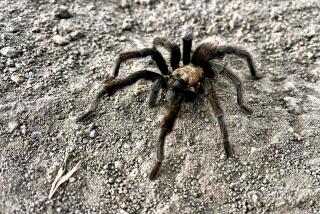Scientist Studies What Ladybugs Do When They Fly Away Home
- Share via
If Newton Copp finds out why ladybugs congregate by the thousands on frozen mountains every winter, he figures it could be news the world is waiting for.
That is why he spent a freezing winter night with clusters of them and struggled awake every two hours to take their temperatures.
And that is why he sat in a walk-in freezer, taking photographs every minute to record the movement of ladybugs on warming plates.
And that is why, in the same freezer at the Claremont Colleges, Copp upends ladybugs by the dozens to check their gender. With a speck of well-chewed bubblegum on a toothpick, he picks them up, separates females from males and then watches them pair up.
“I think some people think this is an odd thing for a grown man to be doing, especially with ladybugs,” Copp said.
He is a strapping, 36-year-old assistant professor of biology at Scripps College, a man who climbs mountains and ponders big questions--such as why do animals, including humans, congregate?
Once, while climbing Mt. San Gorgonio and pondering, Copp saw thousands of ladybugs congregated at an elevation of 6,000 feet. He put some in a plastic bag, took them to the Claremont Colleges’ freezer and thereby had a new project in a field in which little research had been done.
“I had heard about this, but it was the first time I’d ever seen it,” Copp said of the almost-frozen cluster he found on the end of a log.
Ladybugs, he learned, hatch their eggs at lower altitudes where the larvae can feed on aphids. The larvae pupate and emerge as adults who eat aphids in late spring, storing up fat. In late summer most of them begin to aggregate high in the mountains where they mate and spend their winters. Copp thinks they have a lifespan of one year and that the offspring may return to the parents’ mating site.
“The question is: Why should the individual benefit by joining a group?” Copp said. “This happens with all animals--schools of fish, flocks of birds, prides of lions, hives of bees. It’s surprising to see them associating closely because they’re competing for the same things--mates, food and shelter. The more we understand animals’ behavior, the more likely we’ll understand human behavior.”
So far, he says he has learned by checking temperatures on freezing mountains that ladybugs do not cluster to keep warm, that activity increases as they get warm, and that males prefer the largest females--presumably those that have stored the most fat. He suspects that hordes of females produce a scent that attracts males, and clustering enhances reproductive success. He also thinks the spots on their backs are “sort of a landing pattern for mating males, like lights on a runway.”
“Ladybugs are great to work with,” Copp said. “I can collect thousands, keep them in petri dishes for months, and take them out of the freezer when I want them. However, when 500 start walking around I’m in trouble.”
Copp, who has a doctorate in biology from the University of California, Santa Barbara, has done research projects on the brains of crayfish and on a tropical butterfly that feeds only on passion vines.
“Invertebrates do surprising things, showing sophisticated behaviors,” he said. “It’s fun, looking at things on a tinier scale.”
Copp theorizes that the name ladybug, and its European equivalent, the ladybird beetle, may have derived from a medieval concept of the Virgin Mary. The bugs may have been viewed as saintly hundreds of years ago when it was believed that they were associated with fertility.
“It became bad luck to kill them and good luck to wear them as jewelry,” Copp said.
“The question comes up: Why spend time and money researching something so commonplace?” said Copp, who has applied for a research grant from the National Science Foundation.
“It has to do with crop pest management. Ladybugs are applied to crops and rose gardens to eat aphids, but they won’t stay. If you could keep them in the crop, if a chemist could synthesize the scent . . . “
But Copp is more interested in a broader application of his study.
“It’s just interesting to me. There are many ways of contributing to the betterment of our welfare, and one is in increasing our information on all forms of life. This might be a test, a way to shape and reshape theory of behavior on a broader scale. In my own mind, it could do that.”
More to Read
Sign up for Essential California
The most important California stories and recommendations in your inbox every morning.
You may occasionally receive promotional content from the Los Angeles Times.









